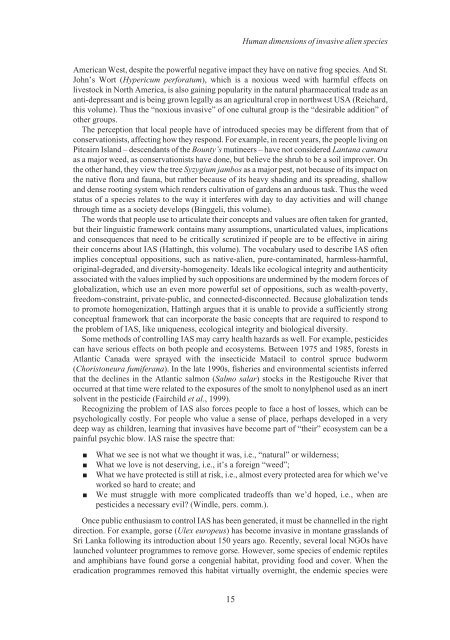Alien Species.vp - IUCN
Alien Species.vp - IUCN
Alien Species.vp - IUCN
You also want an ePaper? Increase the reach of your titles
YUMPU automatically turns print PDFs into web optimized ePapers that Google loves.
American West, despite the powerful negative impact they have on native frog species. And St.<br />
John’s Wort (Hypericum perforatum), which is a noxious weed with harmful effects on<br />
livestock in North America, is also gaining popularity in the natural pharmaceutical trade as an<br />
anti-depressant and is being grown legally as an agricultural crop in northwest USA (Reichard,<br />
this volume). Thus the “noxious invasive” of one cultural group is the “desirable addition” of<br />
other groups.<br />
The perception that local people have of introduced species may be different from that of<br />
conservationists, affecting how they respond. For example, in recent years, the people living on<br />
Pitcairn Island – descendants of the Bounty’s mutineers – have not considered Lantana camara<br />
as a major weed, as conservationists have done, but believe the shrub to be a soil improver. On<br />
the other hand, they view the tree Syzygium jambos as a major pest, not because of its impact on<br />
the native flora and fauna, but rather because of its heavy shading and its spreading, shallow<br />
and dense rooting system which renders cultivation of gardens an arduous task. Thus the weed<br />
status of a species relates to the way it interferes with day to day activities and will change<br />
through time as a society develops (Binggeli, this volume).<br />
The words that people use to articulate their concepts and values are often taken for granted,<br />
but their linguistic framework contains many assumptions, unarticulated values, implications<br />
and consequences that need to be critically scrutinized if people are to be effective in airing<br />
their concerns about IAS (Hattingh, this volume). The vocabulary used to describe IAS often<br />
implies conceptual oppositions, such as native-alien, pure-contaminated, harmless-harmful,<br />
original-degraded, and diversity-homogeneity. Ideals like ecological integrity and authenticity<br />
associated with the values implied by such oppositions are undermined by the modern forces of<br />
globalization, which use an even more powerful set of oppositions, such as wealth-poverty,<br />
freedom-constraint, private-public, and connected-disconnected. Because globalization tends<br />
to promote homogenization, Hattingh argues that it is unable to provide a sufficiently strong<br />
conceptual framework that can incorporate the basic concepts that are required to respond to<br />
the problem of IAS, like uniqueness, ecological integrity and biological diversity.<br />
Some methods of controlling IAS may carry health hazards as well. For example, pesticides<br />
can have serious effects on both people and ecosystems. Between 1975 and 1985, forests in<br />
Atlantic Canada were sprayed with the insecticide Matacil to control spruce budworm<br />
(Choristoneura fumiferana). In the late 1990s, fisheries and environmental scientists inferred<br />
that the declines in the Atlantic salmon (Salmo salar) stocks in the Restigouche River that<br />
occurred at that time were related to the exposures of the smolt to nonylphenol used as an inert<br />
solvent in the pesticide (Fairchild et al., 1999).<br />
Recognizing the problem of IAS also forces people to face a host of losses, which can be<br />
psychologically costly. For people who value a sense of place, perhaps developed in a very<br />
deep way as children, learning that invasives have become part of “their” ecosystem can be a<br />
painful psychic blow. IAS raise the spectre that:<br />
■ What we see is not what we thought it was, i.e., “natural” or wilderness;<br />
■ What we love is not deserving, i.e., it’s a foreign “weed”;<br />
■ What we have protected is still at risk, i.e., almost every protected area for which we’ve<br />
worked so hard to create; and<br />
■ We must struggle with more complicated tradeoffs than we’d hoped, i.e., when are<br />
pesticides a necessary evil? (Windle, pers. comm.).<br />
Once public enthusiasm to control IAS has been generated, it must be channelled in the right<br />
direction. For example, gorse (Ulex europeus) has become invasive in montane grasslands of<br />
Sri Lanka following its introduction about 150 years ago. Recently, several local NGOs have<br />
launched volunteer programmes to remove gorse. However, some species of endemic reptiles<br />
and amphibians have found gorse a congenial habitat, providing food and cover. When the<br />
eradication programmes removed this habitat virtually overnight, the endemic species were<br />
15<br />
Human dimensions of invasive alien species












